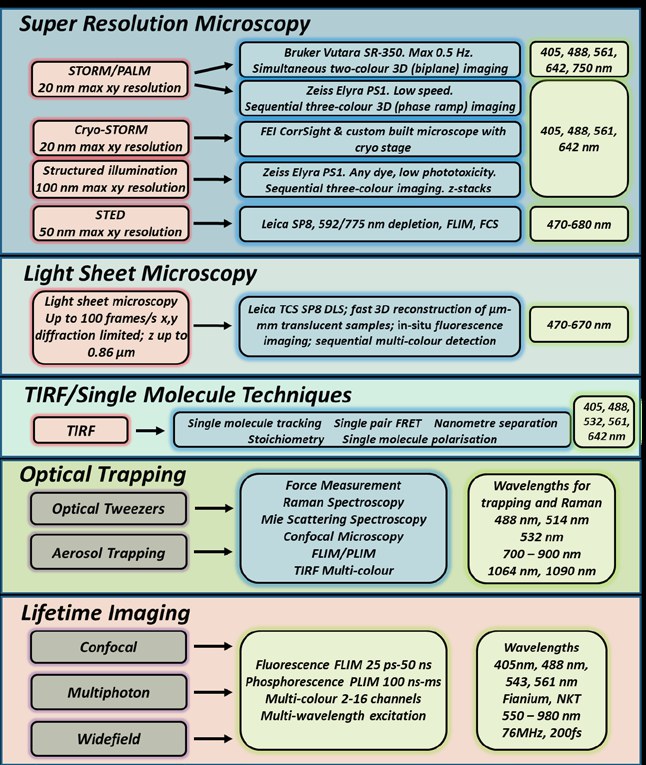CLF (Oxfordshire, UK)
Research highlights
CLF
Central Laser Facility, Rutherford Appleton
Laboratory, STFC, Oxfordshire, United Kingdom
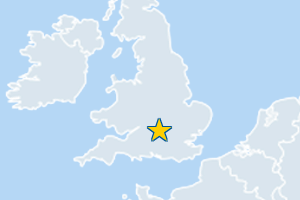
Contact:
Vulcan: Rob Clarke
Gemini: Rajeev Pattathil
Artemis: Emma Springate
Octopus: Marisa Martin-Fernandez
Ultra : Mike Towrie
Vulcan
Laboratory Astrophysics: Characterization of the bulk properties of compressible turbulence in a super-Alfvénic plasma was performed on the Vulcan Laser [Nat. Commun. 10, 1758 (2019)].
Electromagnetic pulses: Using the Vulcan laser at the Central Laser Facility, the record for the highest energy in a single pulse of terahertz radiation has been achieved in the laboratory [PNAS 116, 3994 (2019)].
Gemini
Quantum Electrodynamics: Users of the Gemini facility collided a high intensity laser pulse with a multi-GeV electron beam to study the dynamics of electrons in strong fields, providing evidence of radiation reaction energy loss [Phys. Rev. X 8, 011020 (2018)] [Phys. Rev. X 8, 031004 (2018)].
X-ray imaging: Gemini experiments have demonstrated the suitability of the laser-betatron radiation produced in laser-wakefield accelerators to conduct radiography and tomography for medical and industrial applications [PNAS 115, 6335 (2018)] [NIMA 983, 164369 (2020)].
Artemis
Condensed matter physics: The combination of XUV photon energy and femtosecond time-resolution on Artemis enables studies of ultrafast electron dynamics across the full Brillouin zone in condensed matter, using time- and angle-resolved photoemission spectroscopy. Recent work extended this technique to a high temperature superconductor, where we observed transient emergence of quasiparticles at the antinodes [Science Advances 4, eear1998 (2018)].
Coherent lens-less imaging with high harmonics: The spatial coherence of extreme ultraviolet pulses produced through high harmonic generation enables them to be applied to coherent lensless imaging techniques with high spatial resolution. Recent measurements on Artemis enabled a biological sample to be imaged over a wide area with 80-nanometre resolution. [Science Advances 6, eeaz3025 (2020)].
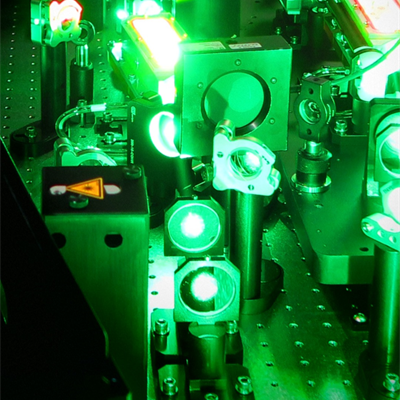
Octopus
Antimicrobial resistance: Super-resolution microscopy techniques have been used to study the uptake and mode of action of potential new antimicrobial drugs by bacteria [Chem. Sci. 11, 8828 (2020)].
Cancer Research: Single molecule and super-resolution microscopy techniques have revealed the molecular architecture of signalling molecules in cells, and identified structural differences in mutants involved in cancer [Nat. Commun. 9, 4325 (2018)].
Ultra
Catalysis: Kerr-gate Raman spectroscopy has allowed the identification of contaminants responsible for the deactivation of zeolite catalysts [Nature Materials 19, 1081 (2020)].
Charge flow in organic semiconductors: Organic semiconductors & molecular wires have many emerging applications, e.g. display devices in mobile phones, in photovoltaic solar cells, and potentially in restorative medicine. Work on Ultra has provided fundamental insights into the mechanisms of charge transport, useful in guiding the design of better materials [Chem. Sci. 11, 2112 (2020)].
Projects performed by external users >>
Further application highlights
Lasers and the Universe Lasers and Cancer Lasers for Fusion Energy Lasers for Cultural Heritage Lasers for Clean Energy
Expertise
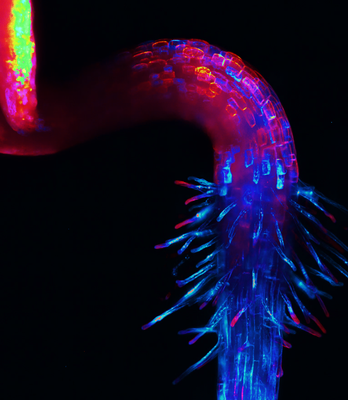
Vulcan is a Petawatt laser system that enables the study of laser-matter interaction at intensities up to 1021 W/cm2 and the flexible beam configuration enables production of high-energy density matter at extreme temperatures. The research areas include fusion energy, electron and ion acceleration, laboratory astrophysics and plasma physics.
Gemini offers two independent beams of up to 500 TW in flexible configurations. Research includes investigations of new LWFA and channelling schemes, trialling new beam configurations and targetry. LWFA can also be used for production of intense radiation sources such as x-rays, positrons, and muons. Proof of principle demonstrations of hard x-ray tomography have shown their wide range of applicability from high resolution biological imaging to penetrative flash radiography of large dense object.
Artemis is based on high repetition rate, few optical cycle and widely tuneable laser sources, and ultrafast XUV (10-100’s eV) pulses produced through high harmonic generation. Vacuum beamlines deliver the synchronised pulses to end-stations for condensed matter physics and gas-phase chemistry. Experiments on Artemis use high harmonic generation to investigate ultrafast dynamics in experiments on gas and solid materials using photoelectron spectroscopy. We also exploit the spatial coherence of the XUV to use coherent diffractive imaging techniques.
Octopus offers a range of imaging techniques including several modes of multidimensional single molecule microscopy (particle kinetics and dynamics in live cells via single particle tracking colocalisation, single particle FRET and single particle polarisation, and structure determination in fixed cells - at 5-20 nm resolution via fluorescence localisation with photobleaching (FLimP)), super-resolution microscopy (STORM, PALM, SIM, STED), and confocal microscopy (FLIM, FRET, and multiphoton). Optical Tweezers is another technique that OCTOPUS provides.
Ultra is a word-class time-resolved (pump-probe) spectroscopy facility. Ultra offers a wide range of spectroscopy techniques including transient absorption, 2D-IR, femtosecond stimulated Raman, IR-vis sum frequency generation, Kerr-gated fluorescence, Kerr-gated Raman, Time resolved IR absorption, Time-Resolved Resonance Raman, and Time-Resolved Multiple-Probe spectroscopy (TRmPS).
Equipment offered to external users
Target Fabrication Facility
The Target Fabrication group has access to a wide range of facilities that are able to fabricate the most complex of targets for both the TAP and TAW high power experimental areas and also the Gemini high repetition rate area. Through rigorous planning procedures that are ISO9001:2008 compatible we aim to deliver the highest quality targets in time for your experiment and to provide the flexibility during an experimental run that allow the maximisation of the time available on the facilities.
Current Target Fabrication Capabilities include: Thin Film Coating, Micromachining, Low Density Materials, Medium Rep-rate technologies, Characterisation, MEMS Fabrication, Gas Targetry and Cryogenic Targetry.
Vulcan
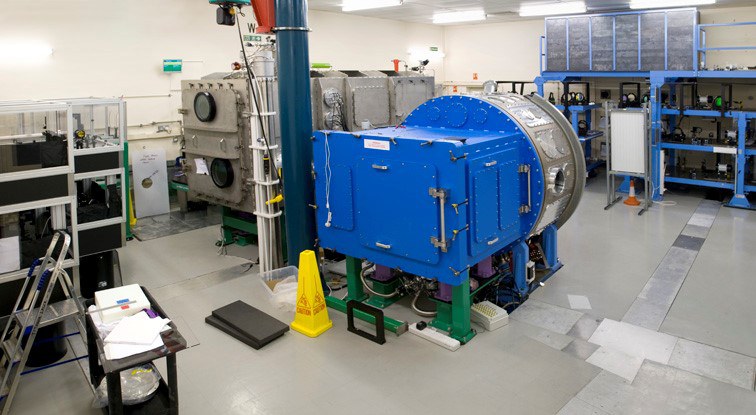
Vulcan Target Area Petawatt (TAP):
- TAP offers 1 PW (500 J/500 fs) configured for delivering the highest intensity using an F3 focusing optic, achieving intensities of up to 1021 W/cm2. Pulse length and energies are configurable from 0.5 ps to tens of ps on request and up to 600J prior to compression. On-shot diagnostics include near and far field images, energy, spectrometer, autocorrelator and contrast diode
Vulcan Target Area West (TAW):
TAW can provide up to 8 beams: 2 CPA beamlines and 6 long pulse beams
- Beamline B7 operates with an energy limit of ~100 J prior to compression and a compressed pulse duration of ~1 ps. Beamline B8 has 2 operating modes. Mode 1 has the same specifications as B7. Mode 2 operates at 300J prior to compression for pulse durations of 15ps or longer. Typical experimental configurations B7 and B8 orientated at 90 degrees and deliver intensities of up to mid-1019 W/cm2 for pump-probe experiments. Other configurations are available.
- Six long pulse beams delivering a combined 1.6 kJ can be configured alongside the CPA beams in multiple configurations, including single side cluster, cylindrical and spherical compression geometries. The shape of the pulse can be shaped with a temporal resolution down to 100ps, and conversion into second harmonic is available on all long pulse beams.
- A range of diagnostics and equipment are available for use on experiments at the facility. For both the optical and x-ray ranges this includes scientific cameras, streak cameras and spectrometers. Nuclear and particle diagnostics are available including charged particle spectrometers, neutron detectors and activation detectors.
Gemini
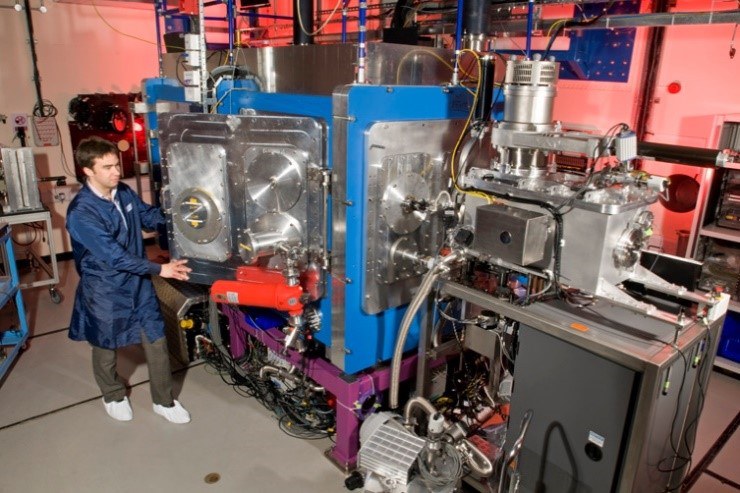
- Gemini is a versatile area with a large target chamber that can be configured for the various beam arrangements required. The North and South beams enter the area from above and are steered onto f/20 (3m focal length), f/40 (6m focal length), or f/2 (30cm focal length) parabolic mirrors with the smallest focal spot being about 2 microns, producing an intensity up to 2 x 1021 W cm-2.
- To achieve very high contrast, the North beam has the option of a passing through a double plasma mirror system consisting of two f/7 parabolic mirrors focusing onto a pair of anti-reflection coated substrates.
- Adaptive optics are available for optimising the quality of the laser focal spot.
- A range of plasma diagnostics is available for experimental users
Artemis
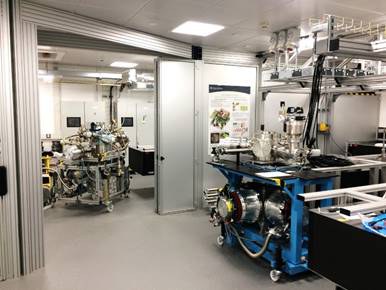
Artemis provides ultrafast laser sources, three XUV beamlines and end-stations for atomic and molecular physics, condensed matter physics and imaging.
The laser sources are:
- High average power Ti:sapphire laser system (twin 8 mJ, 30 fs pulses at 1 kHz).
- Few-cycle laser pulses: 12 fs pulses at 1800 nm with 0.4 mJ/pulse at 1 kHz.
- Tuneable pulses from 235 nm to 15 micron at 1 kHz.
- 100 kHz IR system, with outputs at 1700 nm and 3000 nm. Available for users from 2021.
The three XUV beamlines are:
- Tuneable XUV beamline, with monochromator providing isolated, short pulse (10-50 fs) harmonics in the energy region 12-80 eV
- XUV imaging beamline with flatfield spectrometer, filters and multilayer mirrors, for experiments requiring higher XUV flux.
- Beamline for 100 kHz XUV pulses. Available for users from 2021.
Artemis has a variety of vacuum end-stations, which can be used with XUV or laser pulses.
- Time- and angle-resolved photoemission (ARPES) chamber for condensed matter physics
- UHV time-of-flight chamber for studies of ultrafast demagnetization
- AMO chamber with velocity-map imaging or electron time-of-flight detector and gas sources
Ultra
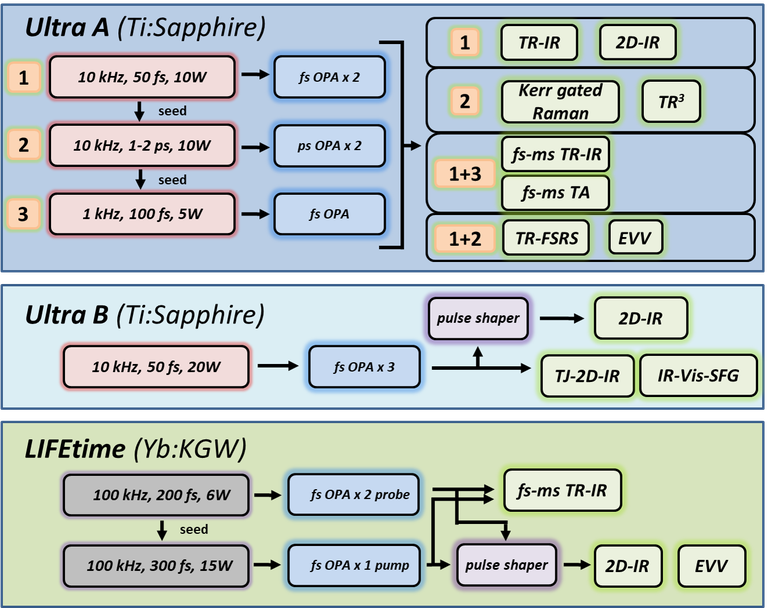
Ti:Sapphire and Yb:doped chirped pulse amplifiers capable of producing fs and/or ps pulses.
- 2 x Thales laser ALPHA 10000: 10 kHz dual synchronised Ti:Sapphire 800 nm, 40 fs and 2 ps output, providing 2 x 1 mJ pulses. Harmonics 400, 267, 200 nm.
- Spectra Physics Spitfire: 1 kHz Ti:Sapphire 800 nm, 120 fs output, providing 4 mJ pulses. Harmonics 400, 266, 200 nm.
- 2 x Light Conversion Pharos laser (LIFEtime): 100 kHz dual synchronised Yb:doped lasers 1030 nm, ~200 fs outputs, providing 0.07 and 0.15 mJ pulses. Harmonics 515, 343, 257, 206 nm.
- Coherent Legend Elite with Cryo PA: 10 kHz Ti:Sapphire 800 nm, 40 fs 2 mJ pulses driving dual optical parametric amplifiers with difference frequency mixing.
- Optical Parametric Amplifiers (OPA, Light Conversion TOPAS and Orpheus) provide access to a range of tunable pump-probe configurations (190-20000 nm), allowing access to techniques such as pump-dump and transient 2D-IR (UV-vis pump, IR pump) spectroscopy. The OPAs include a short pulse Non-collinear Parametric Amplifier (NOPA, Light Conversion TOPAS-White).
- Broadband probes include White Light Continuum (WLC) generation in UV near IR from 330-1600 nm and OPA Difference Frequency Generation (DFG) with > 300 cm-1 bandwidth in mid infrared from 800-4000 cm-1.
Supplementary lasers
- 1-20 kHz pulsed nanosecond laser (Innolas or Wedge Laser): 1064 nm with 0.8 ns pulse. Active Q-switch with <0.5 ns jitter. Provides extended pump – probe delays from 1 ns-1 ms i.e. beyond the range of optical delay lines. Harmonic 532, 355, 266, 213 nm with several microjoules energy per pulse.
- kHz pulsed nanosecond laser (Wedge): 1064 nm, 4 mJ output energy with 1 ns pulse and active Q-switch <0.5 ns jitter. This laser pumps a PPLN OPO to generate IR light in the 2100 to 3800 nm spectral region with >50 µJ energy per pulse.
Octopus
The Octopus facility supports and develops the latest microscopy techniques to enable successful applicants to perform complex studies in the areas of biological, chemical, environmental and materials science. A comprehensive range of laser-based imaging techniques and sample handling are supported.
